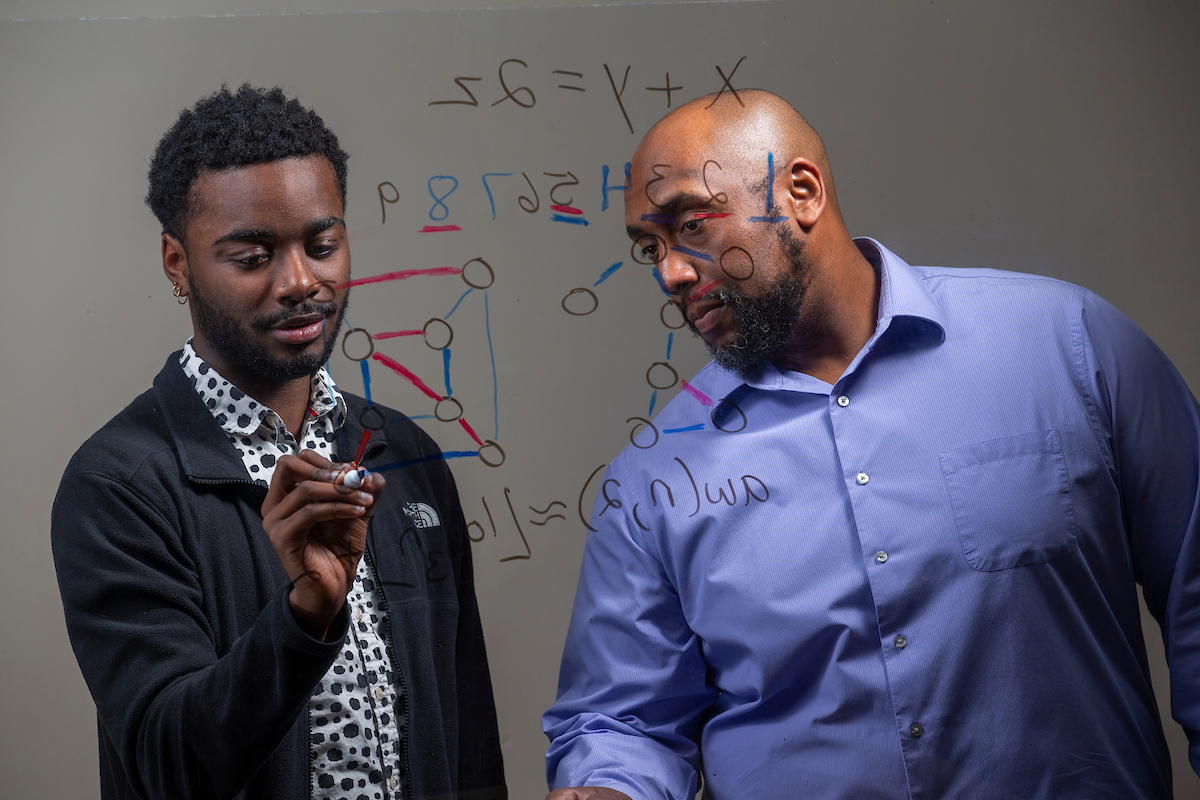Being exceptionally skilled at math was the central thread that ran through Michael Young’s life, identity and sense of purpose—until he reached graduate school. When that thread began to unravel, an unfamiliar confluence of self-doubt and frustration set in and threatened to derail his dreams of becoming a math professor.
These painful times would provide the foundation from which Young, associate professor of mathematics, would build an advocacy-driven career that would transcend equations in textbooks and lessons in lecture halls.
“Michael Young is a rising star in mathematics at Iowa State and on the national stage,” said Hal Schenck, professor and chair of the mathematics department. “He is also an accomplished researcher who was recently honored with the 2019 Liberal Arts and Sciences award for mid-career achievement in research.”
Young’s expertise in combinatorics and graph theory has resulted in three recent National Science Foundation (NSF) awards: An individual $60,000 grant, an NSF INCLUDES grant and he is also a co-principal investigator and key player in the math department’s $1.5 million Research Training Group award.
Whether he is tutoring one student who is struggling with combinatorics—or developing a post-baccalaureate (post-bac) program for many—Young’s student-focused approach has lifted, transformed and rocked the career paths of many who have studied mathematics at Iowa State University.
“It’s my mission to ensure that students get what they need to achieve their dreams,” said Young. “Sometimes that means tutoring, but often it means connecting with students and empowering them through programs and individualized plans that serve the whole person, not just the student.”
“I ran clear across campus.”
Jose Lopez (post-bac ’19 math) rushed up four flights of stairs and stopped short at Young’s open office door in Carver Hall. Nearly out of breath, and wearing a wide grin—Lopez could barely contain his good news.
“I got into Cambridge!” he said.
Moments earlier, Lopez learned that he had been accepted into the Department of Pure Mathematics and Mathematical Statistics at the prestigious University of Cambridge, in the United Kingdom. This summer, Lopez will travel to England where he will begin graduate classes in the fall.
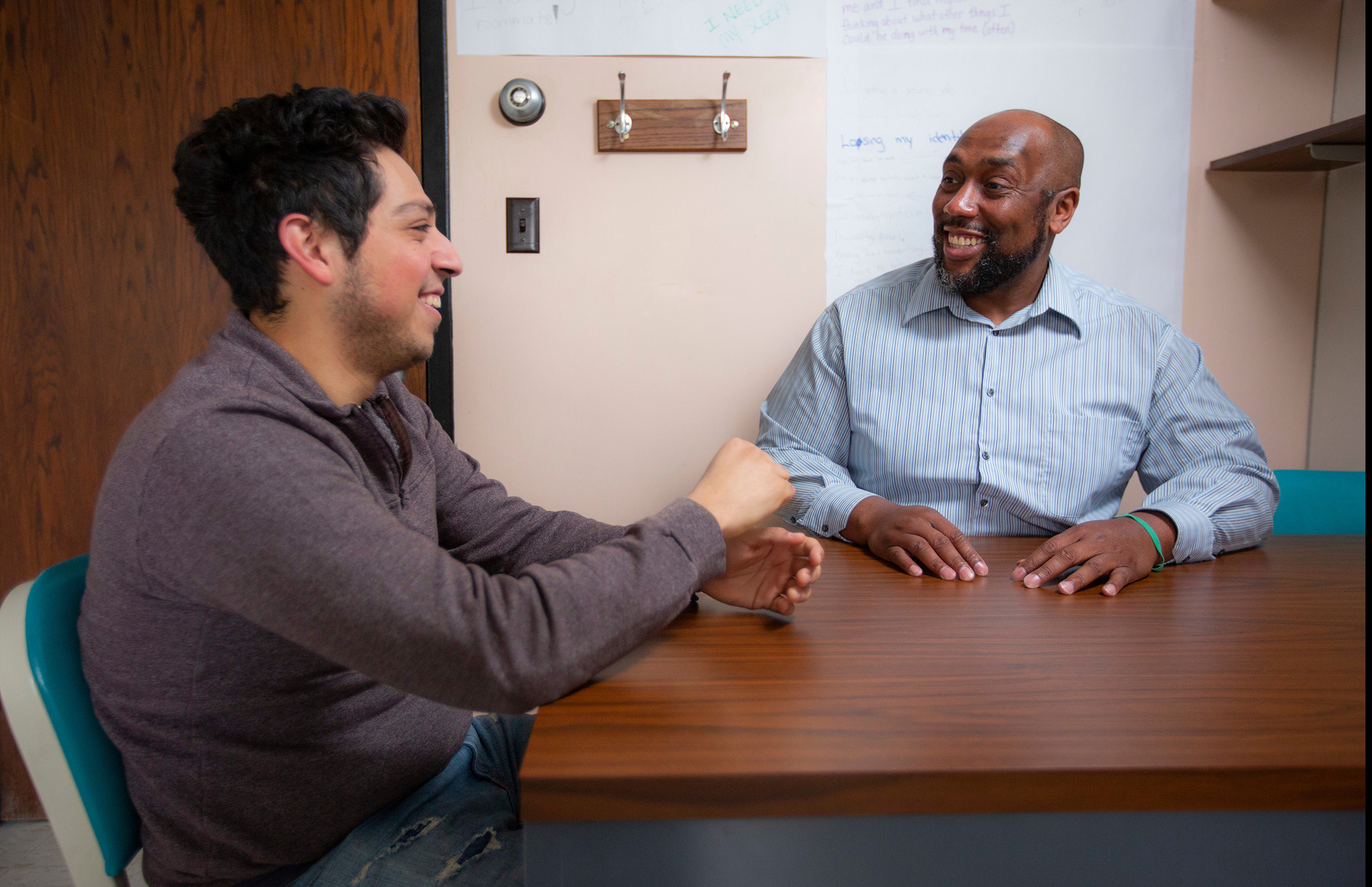
“I absolutely had to tell Michael first because he helped me to achieve this dream,” said Lopez.
“Michael has created an incredible community of support for Iowa State math students. I am fortunate to have a mentor who was so invested in my success.”
Lopez also credits Iowa State’s post-bac program with playing a pivotal role in his academic success and acceptance at The University of Cambridge. His mentor, Michael Young, co-founded the program with Bernard Lidický, associate professor of mathematics. Young currently serves as the program director.
“I applied to graduate schools last year and didn’t make it,” said Lopez. “A year in the post-baccalaureate program made all of the difference. Now, I’ll be attending my dream school.”
A bridge to success
Iowa State began offering the post-baccalaureate certificate in mathematics in the fall of 2018. This one-year program is designed to help undergraduate degree holders smoothly transition into the rigors of a graduate mathematics program.
Young’s graduate school challenges inspired him to create the program. “In graduate school, I was introduced to combinatorics and graph theory, math that I had never seen before, and it was a rough experience that nearly derailed my plans to earn a Ph.D.,” he said. “Since then, I’ve made it my mission to develop a program that bridges the math skills gaps between undergraduate and graduate school.”
Some students enter the post-bac program immediately after earning their undergraduate degree. Others, like Kevin Liu, enroll after years of working in a math-related career.
“Out of this experience, I grew to understand how important it is to for universities to have formal programs and services in place, before students hit crisis points.”
“I taught high school math for three years, and sometimes when I was grading papers, I felt a yearning to return to college and earn my Ph.D.,” said Liu. “However, I was afraid that graduate school would be tough after being away from academia for a while. My advanced math skills were rusty and I had some catching up to do.”
Liu discovered Iowa State’s post-bac certificate while perusing graduate schools online. After learning that the program offered faculty mentoring and tailored course plans that addressed math deficiencies, he applied and was accepted for the 2018-19 academic year. “I remember thinking that this program is exactly what I need-just one year to sharpen my math skills and to show graduate colleges what I can do,” he said.
This spring, after eight months in the post-bac program, Liu was accepted into the Ph.D. program in mathematics at the University of Washington in Seattle, a highly competitive program with only 17 open spots.
“Kevin Liu and Jose Lopez demonstrate the importance of the post-bac certificate,” said Young. “This is the program that I needed in graduate school and it is an honor to help students achieve their dreams and avoid some of the challenges that I experienced."
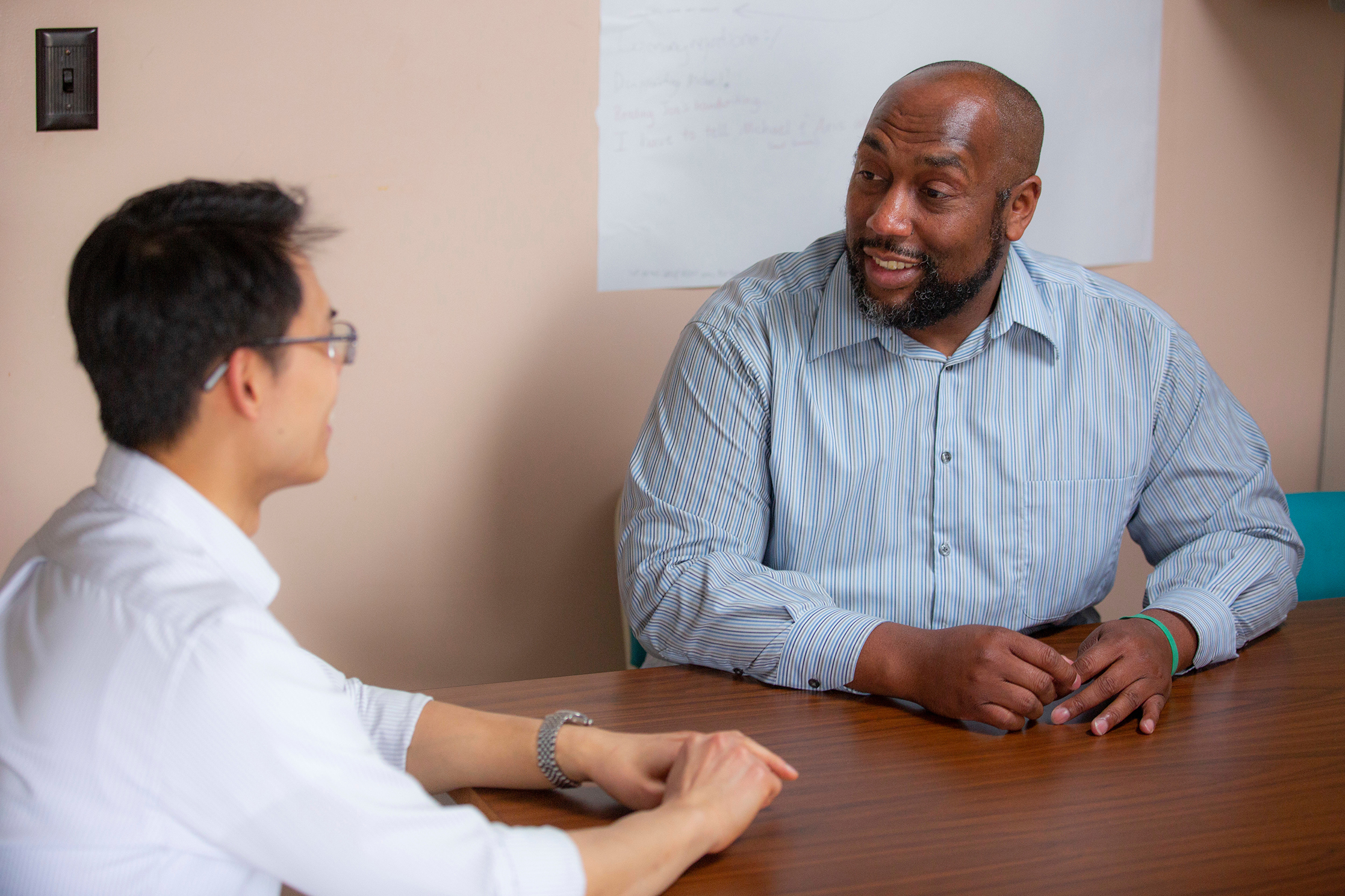
Math had been the center of Young’s universe since he was a child. No middle-school math test was too difficult and no high-school calculus problem was left unsolved. His graduate school struggles felt foreign, after a life time of math accomplishments, gold stars and an undergraduate scholarship to study math at the University of Florida.
Rising math star
In elementary school, Young wowed his teachers and surprised his parents with a perfect score on a standardized math test. This achievement launched him into the gifted program and by junior high he was breezing through advanced math courses. Numbers felt like old friends that were always there for him, boosting his confidence and allowing him to stand out from the crowd.
“Math was the place where I felt most comfortable,” said Young. “Numbers and working through math problems, had always been my respite.”
Math also helped Young cope and thrive through the rough patches of adolescence.
Although his junior high school was riddled with violence, drugs and bullies, Young coped by disappearing into story problems and fixating on formulas. “Every day I was terrified, but working on math helped me to survive the chaos,” he said. “All of my fears and anguish disappeared when I was doing math.”
By high school, math had become a celebrated part of his identity.
Many students can name their high-school’s quarterback or student-body president; at Young’s high school it was common knowledge that he was often at the chalkboard teaching his AP calculus class or sitting at the teacher’s desk, tutoring his peers.
“Math was the place where I felt most comfortable. Numbers and working through math problems, had always been my respite.”
From his days in elementary school to his undergraduate years at the University of Florida—math had been a constant force that allowed him to shine as a child, gain comfort during middle school and find purpose throughout high school and college.
However, after starting graduate school, the solid ground of mathematics, seemed to crumble under his feet.
More than miles from home
Carnegie Mellon University in Pittsburgh, where Young attended graduate school, is nearly a thousand miles from Florida-where he was born, raised and earned his undergraduate degree in mathematics.
For Young, it was much more than distance that separated the two locations.
“I decided to quit graduate school seven times,” said Young. “And every time I walked into the graduate director’s office and announced that I was done, I was dead serious about wanting to leave.”
The cultural demographics that defined this small, private Northeastern college, were worlds apart from the diverse backdrop of the South, where Young had spent his entire life. He felt alone and different—like an alien who had been dropped off on another planet.
Adjusting to a new culture and environment was especially challenging as he battled with graduate-level math. “I was used to working hard to excel in math, but this was very different,” said Young. “For the first time in my life, I was being asked to do math that I could not do. I was ill-prepared for that.”
Math, the one constant that had played so many important roles in his life, was now a source of stress. “For years, math defined me, boosted my confidence and gave me comfort. Now, that was all gone and it was a very tough period in my life,” he said.
Problems and answers—beyond the math textbooks
Instead of packing his bags and leaving graduate school, Young fought through each day—until the days turned into weeks and glimmers of hope materialized. Faculty members offered their time and support while signs of progress emerged.
Then something transformative began to happen.
“As I received guidance, tutoring and mentorship from faculty members, I observed that this help was on-the-fly,” said Young. “There were no programs in place and we were making it up as we went along, but the results were helpful and I was so grateful,” said Young.
“Out of this experience, I grew to understand how important it is for universities to have formal programs and services in place, before students hit crisis points.”
In addition to addressing the academic needs of students, Young also developed a network of programs and services that address the cultural needs of students of color, women and underserved populations who study mathematics at Iowa State University.
“I nearly quit graduate school after feeling different and alone. We can’t underestimate how important this is. You can lose students who fail academically, but you can also lose students who feel unsupported, or like they don’t belong.”
“I nearly quit graduate school after feeling different and alone. We can’t underestimate how important this is,” said Young. “You can lose students who fail academically, but you can also lose students who feel unsupported, or like they don’t belong.”
“I am at Iowa State because of Michael Young.”
Young secured a $300,000 grant from the National Science Foundation to develop and pilot the Mathematicians of Color Alliance (MOCA), a national network of local college chapters that provide support, connection and services to minorities who are studying college mathematics.
“Dr. Young is much more than just a talented researcher—he is doing wonderful work in outreach and mentoring of groups that are underrepresented in mathematics,” said Schenck. “In recognition of his efforts he was honored in 2018 with Iowa State’s MLK Advancing One Community Award.”
Iowa State MOCA members, like Christian McRoberts (Ph.D. ’23 mathematics), serve as mentors to local public-school students and work with area teachers to ensure that underrepresented students are prepared for college-level math. “MOCA eased my transition into graduate school at Iowa State,” he said. “The group provides connection and socialization. We study together and support one another.”
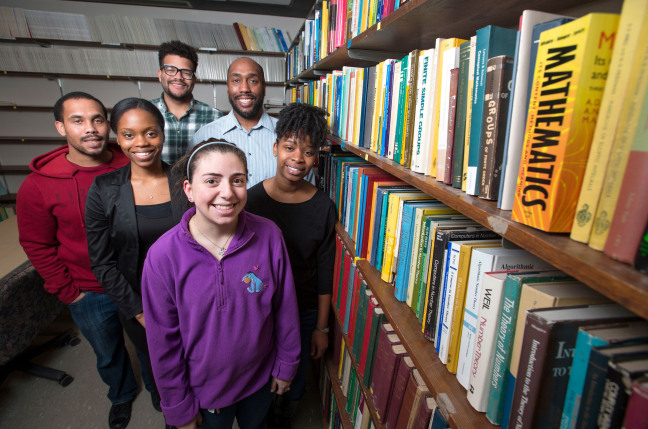
McRoberts spent the summer before his senior year in college hopscotching around the country and attending math conferences. He was searching for a graduate school and a smooth transition from his undergraduate experience at Morehouse College—an all-male, historically black college in Atlanta. Young introduced McRoberts to Iowa State University.
“Many colleges don’t follow through after they recruit you, but what Michael promised me about the mathematics program and the support network at Iowa State is exactly what I’ve experienced,” said McRoberts. “There is tremendous commitment to underrepresented students at Iowa State. Whether you are gay, black, Latino or whatever, the faculty and administration truly care about your growth.”
“I came to Iowa State because Michael Young recruited me,” said McRoberts. “Now, I’m thriving here because of the encouragement and guidance that I’ve received.”
Math Therapy
If the walls in Michael Young’s office could talk, they’d speak about the revolving door of students that check in, stop to chat and sit down for lengthy discussions about future plans.
As it turns out, his office walls have quite a lot to say.
Covered with heavy craft paper, those walls are peppered with phrases, notes and outpourings from students. The posts range from rants about difficulties concentrating in class to musings about a stressful homework assignment. There’s a separate wall for touting good news and accomplishments.
“Students know that they can come to my office and talk about anything,” said Young. “If students have problems or experience tough times, we talk about it. I tell them to grab a pen, put it up on the wall and let it go. It helps students to process what they’re going through and the many messages illustrate that no one is alone.”
Shanise Walker (MS math ’16, Ph.D. ’18) credits Michael’s empathy and accessibility with shaping her positive Iowa State experience. “During one of our sit downs, Michael said, ‘Do you want to be comfortable or do you want to be great?’ Those words continue to impact my life and career,” she said.
Walker currently is an assistant math professor at the University of Wisconsin-Eau Claire. Like McRoberts, she was recruited to Iowa State’s graduate mathematics program after speaking with Young.
“Michael is always in the right place helping and inspiring people,” said Walker.
Young has been involved with the SAMS (Summer Academy for Mathematics and Science) program for several years. Last summer he invited Walker to join the cause. This six-week summer program allows minority students to engage in a rigorous STEM curriculum taught by volunteer faculty like Young and Walker. These educators—who are also people of color, women and members of underserved populations—demonstrate to these students that people who look like them are thriving in STEM careers.
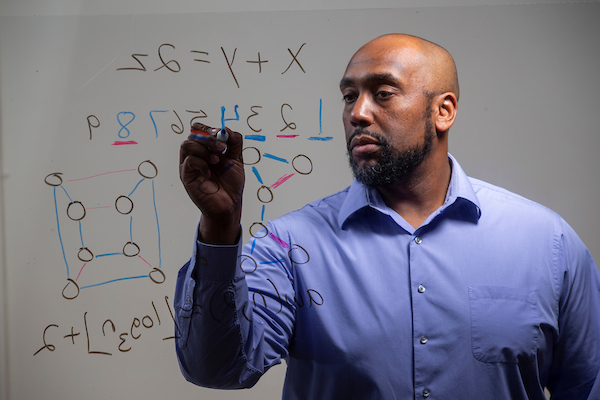
“Michael impacted my career path, and because he’s such a great connector, I’m now impacting students and their STEM career paths,” said Walker. “Whether you are a high school student, a college student or a math professor, your success story is dependent upon meeting the right people and Michael Young is one of the right people.”
Smashing current math narratives
In addition to serving individual student needs, Young is also punching holes in society’s broader perceptions about math.
“Society tells us that it’s okay to hate math and to give up on it,” said Young. “I always ask students, ‘Ok, who ruined math for you?’ and one hundred percent of the time they name a teacher or a role model who made them feel inadequate.”
Young refers to the process of healing these wounds as “math therapy.”
Working on the front lines to repair this damage, Young spoke to teachers at the National Council of Supervisors of Mathematics annual conference in San Diego, in April. He stressed their critical role in ensuring that their classrooms are equitable, inclusive and a place where all kids can feel like math success stories.
“If students have problems or experience tough times, we talk about it. I tell them to grab a pen, put it up on the wall and let it go."
“Look at me. I certainly don’t fit the profile of what a math professor looks like,” said Young. “Media images of mathematicians often exclude women, people of color and other minorities. It’s time to show all kids that mathematicians can and do look like them, so they understand that math success is achievable.”
Young recently shared his experiences as a math professor with Ames elementary students. By sharing his journey as a mathematician of color, Young hopes to expand the definition of “mathematician” in the minds of these young kids.
After circulating around a third grade room, Young encountered a young black student whose reaction continues to inspire his math-advocacy work.
“This student stared at me and he kept repeating, ‘You do math? Are you sure you do math?’ He couldn’t believe it,” said Young. “This is why changing lives and changing narratives is so important. This is about fairness and showing kids what is possible for them.”
Young is well aware that his journey with math—which began in grade school and peaked with challenges in graduate school—has shaped his mathematics career. “Part of the road was challenging and painful but those experiences gave me insight and perspective that I would not change for anything. I’m using it all for good.”
By falling through the cracks during graduate school, Young discovered a mission and a passion to help math students rise.
